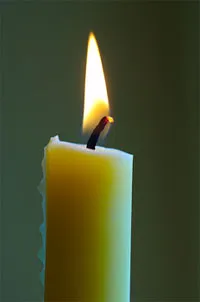 The Teacher's Corner
The Teacher's Corner
The Hottest Part of the Flame
This week's experiment comes from a question that I got during an energy show this week. A student asked what color flame was the hottest. It is a great question, and the answer may fool you.
 To investigate this, you will need:
To investigate this, you will need:
- a candle
- wooden toothpicks or matchsticks
- a metal spoon
- a bowl of water
First a warning. We will be using the candle flame to burn the toothpicks. Be sure you have an adult with you and use common sense. Don't burn plastics as some of them produce toxic fumes when they burn.
Light the candle and look carefully at the flame. At the bottom, you will see an area of blue flame. Above that is the yellow part of the flame. If you look carefully, you will see a darker area in the center. If you look very closely (be careful not to burn your nose) you may also see a very thin layer of blue flame over the entire surface of the flame.
Now, which part of this flame is the hottest? Lets see if we can use a wooden toothpick to find out. Hold one toothpick and put the end of it into the blue area at the base of the flame. Notice how long it takes for it to catch fire. Quickly put the burnt toothpick into the bowl of water. Try the same thing in the flame just at the top of the wick. Did it catch fire quicker? Yes. OK, now lets move upwards to the top of the dark area inside the flame. Last, try holding a toothpick at the very top of the flame. Which toothpick caught fire quickest? The top one, right? So that is the hottest part of the flame, right? NO!
This is an example of how experiments can be misleading. Actually, the hottest part of the candle flame is the blue part, at 2552 degrees F (1400 C.) That is where the flame has the most oxygen and you are getting complete combustion. The reddish part is the coolest part, about 1472 F (800C).
Wait a minute. If the top is not the hottest part, why did the toothpick burn the fastest there? To get an idea of the answer, turn on the hot water in your sink. Hold a metal spoon in the stream of hot water for about 15 seconds. By that time, the spoon should have heated up to the same temperature as the water. Remove the spoon from the water and touch it with your finger. Notice how hot it feels. Then carefully put your finger into the stream of hot water. Does it feel hotter than the spoon? Yes! If they are the same temperature, why does the water feel hotter? Heat energy is moving from the spoon to your finger. The spoon is heating your finger,
but your finger is cooling the spoon.
With the stream of hot water, heat moves from the water to your finger, but then that water flows past and your finger is now touching more water, which still has all its heat energy. You have a constant stream of fresh, hot water transferring heat to your finger, so your skin heats up faster than it did with the spoon. The same thing happens in the candle flame. The heated gases of the flame are rising. Holding the toothpick at the top of the flame means that it has a constant stream of freshly heated gases flowing past it, so the toothpick heats faster and it bursts into flame. At the bottom of the flame, it is more like the spoon. The toothpick cools the flame as the flame heats the toothpick, so it takes longer before the wood is
set on fire.
Once again, be safe and be careful. Have a fun filled week.
 Check out more Science Experiments
Check out more Science Experiments
All lessons are brought to you by The Teacher's Corner and Robert Krampf's Science Education Company.
Robert Krampf's Science Shows thehappyscientist.com